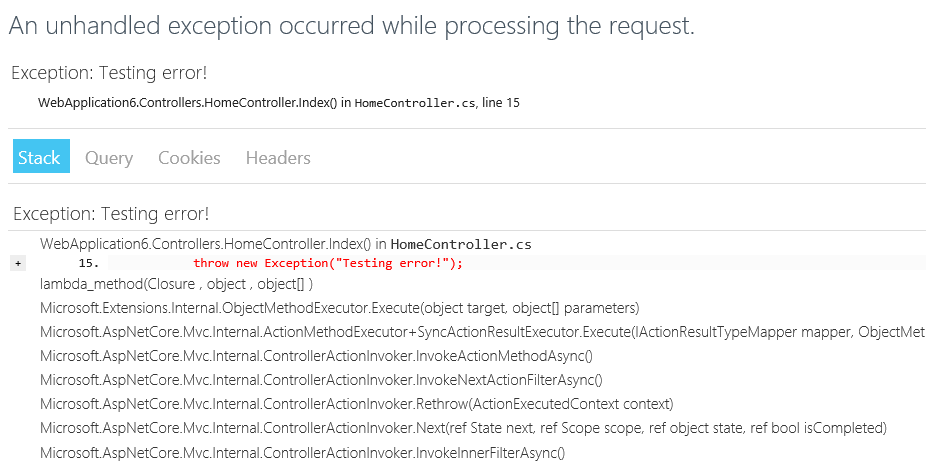ASP.NET Core中,UseDeveloperExceptionPage扩展方法会吃掉异常
在ASP.NET Core中Startup类的Configure方法中,有一个扩展方法叫UseDeveloperExceptionPage,如下所示:
// This method gets called by the runtime. Use this method to configure the HTTP request pipeline. public void Configure(IApplicationBuilder app, IHostingEnvironment env) { if (env.IsDevelopment()) { app.UseDeveloperExceptionPage(); } else { app.UseExceptionHandler("/Home/Error"); } app.UseStaticFiles(); app.UseCookiePolicy(); app.UseMvc(routes => { routes.MapRoute( name: "default", template: "{controller=Home}/{action=Index}/{id?}"); }); }
UseDeveloperExceptionPage方法是所属DeveloperExceptionPageExtensions类的IApplicationBuilder扩展方法,这个方法是新建ASP.NET Core项目时默认加入Startup类中的,它的作用是ASP.NET Core在开发环境(Development环境)下用于展示异常信息页面,如下所示:

但是UseDeveloperExceptionPage方法有一个很坑的特性,那就是它会吃掉ASP.NET Core中Middleware管道中的异常。
我们来设想,假如我们定义了下面一个Middleware叫LoggerMiddleware,它使用try catch代码块,来记录所有发生在ASP.NET Core的Middleware管道中抛出的异常到日志:
public class LoggerMiddleware { private readonly RequestDelegate next; public LoggerMiddleware(RequestDelegate next) { this.next = next; } public async Task Invoke( Microsoft.AspNetCore.Http.HttpContext context) { Logger logger = LogManager.GetCurrentClassLogger(); //logger.Log(NLog.LogLevel.Info, "Log tracking start!"); try { await next.Invoke(context); } catch (Exception ex) { LogMessageGenerator logMessageGenerator = new LogMessageGenerator(() => { return ex.GetType().FullName + "\r\n" + ex.StackTrace; }); logger.Log(NLog.LogLevel.Error, ex, logMessageGenerator); throw; } //logger.Log(NLog.LogLevel.Info, "Log tracking end!"); } }
还有其扩展类LoggerMiddlewareExtension:
public static class LoggerMiddlewareExtension { public static void UsePipelineLogger(this IApplicationBuilder app) { app.UseMiddleware<LoggerMiddleware>(); } }
然后我在ASP.NET Core中Startup类的Configure方法中,将其(app.UsePipelineLogger)放在app.UseDeveloperExceptionPage方法前面:
// This method gets called by the runtime. Use this method to configure the HTTP request pipeline. public void Configure(IApplicationBuilder app, IHostingEnvironment env) { app.UsePipelineLogger(); if (env.IsDevelopment()) { app.UseDeveloperExceptionPage(); } else { app.UseExceptionHandler("/Home/Error"); } app.UseStaticFiles(); app.UseCookiePolicy(); app.UseMvc(routes => { routes.MapRoute( name: "default", template: "{controller=Home}/{action=Index}/{id?}"); }); }
然后你会发现当MVC Controller中抛出异常时,LoggerMiddleware中的try catch代码块捕获不到任何异常。最开始我相当纳闷,这异常怎么活生生地就被吃掉了呢?
后来我在ASP.NET Core中Startup类的Configure方法中,将app.UsePipelineLogger放在了app.UseDeveloperExceptionPage后面:
// This method gets called by the runtime. Use this method to configure the HTTP request pipeline. public void Configure(IApplicationBuilder app, IHostingEnvironment env) { if (env.IsDevelopment()) { app.UseDeveloperExceptionPage(); } else { app.UseExceptionHandler("/Home/Error"); } app.UsePipelineLogger(); app.UseStaticFiles(); app.UseCookiePolicy(); app.UseMvc(routes => { routes.MapRoute( name: "default", template: "{controller=Home}/{action=Index}/{id?}"); }); }
这下LoggerMiddleware中的try catch代码块就成功捕获到了MVC Controller中抛出的异常,这很明确地证明了是app.UseDeveloperExceptionPage方法的Middleware吃掉了ASP.NET Core管道中的异常。
虽然不知道app.UseExceptionHandler方法是不是也会吃掉异常,但是建议大家把捕获异常的Middleware(本例的app.UsePipelineLogger)方法,都放在app.UseDeveloperExceptionPage和app.UseExceptionHandler的后面!






【推荐】国内首个AI IDE,深度理解中文开发场景,立即下载体验Trae
【推荐】编程新体验,更懂你的AI,立即体验豆包MarsCode编程助手
【推荐】抖音旗下AI助手豆包,你的智能百科全书,全免费不限次数
【推荐】轻量又高性能的 SSH 工具 IShell:AI 加持,快人一步
· 10年+ .NET Coder 心语,封装的思维:从隐藏、稳定开始理解其本质意义
· .NET Core 中如何实现缓存的预热?
· 从 HTTP 原因短语缺失研究 HTTP/2 和 HTTP/3 的设计差异
· AI与.NET技术实操系列:向量存储与相似性搜索在 .NET 中的实现
· 基于Microsoft.Extensions.AI核心库实现RAG应用
· 10年+ .NET Coder 心语 ── 封装的思维:从隐藏、稳定开始理解其本质意义
· 地球OL攻略 —— 某应届生求职总结
· 提示词工程——AI应用必不可少的技术
· Open-Sora 2.0 重磅开源!
· 周边上新:园子的第一款马克杯温暖上架